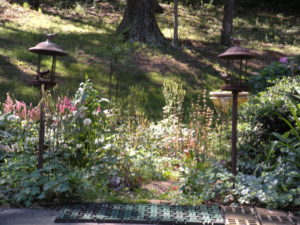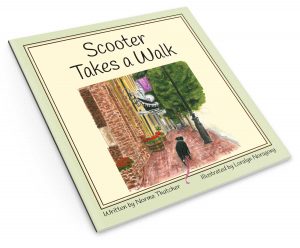
Architect Sarah Susanka’s “Not So Big House” books showed up in my life back when I was designing our home. I was so influenced by her view on the importance of transitions, that I translated her ideas into my own personal ways.
Sarah stresses the need to provide time and ways for people to make a distinction between the outside world with its outside behaviors (such as driving a car, playing running games, getting dirty from yard work, throwing sticks for a dog to retrieve) and the inside world with its own set of behaviors. Give family and visitors time and opportunities to make that transition. Let’s look at how the process works at my home through the senses of a visitor.
My visitor steps out of her car in the driveway and sees a stepping stone path, the opening flanked by ornaments of birds pointing the way to the path. It’s a short curved path that cuts through a garden, so she is likely to linger a moment longer to enjoy my husband’s flowers.
She arrives at a slightly raised small front porch. The wind chimes sound out a soft melody and the two outdoor mirrors reflect the trees from the yard. My visitor, although still outside, is now sheltered overhead and on two sides. She’s being transitioned from outside to inside without being consciously aware of it.
The front door has glass insets and has two side panels of beveled glass. This gives my visitor a view into the home so she can see when someone is coming to greet her. As the red front door is opened to the foyer, a large mirror on the wall reflects the view of the outside world my visitor is leaving behind.
To access the main living area, my visitor takes a one-step turn to the right and one step up. This symbolic turning of direction and level is another opportunity to transition from the outside and be welcomed into the home. At that point, my visitor is facing a wall-hanging of trees in late autumn with their leaves in various stages of clinging to the trees, lying on the ground, or floating in mid-air. She’s seeing nature in transition, just as she herself is in transition.
And from this same spot, if my visitor looks up and to the right, she’ll see a high window that shows an upstairs outer wall and the roof overhang. It’s as if the house is telling her, “You’ve left the outside world, and I’ve got you sheltered.”
These aspects are so subtle that my visitor isn’t even aware of them. She just knows she feels at home. And isn’t that a wonderful transition?
To my readers: Will you share a favorite transition idea from your own living space?



